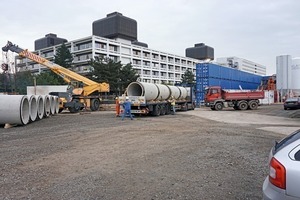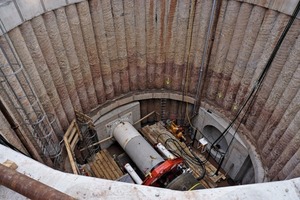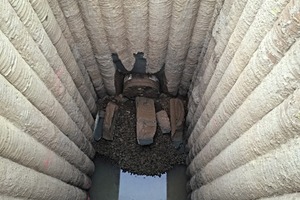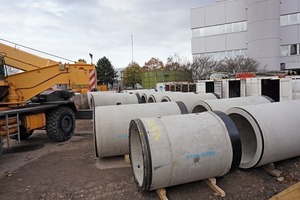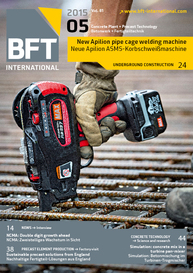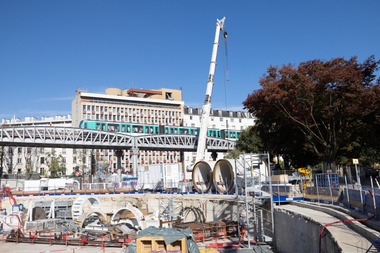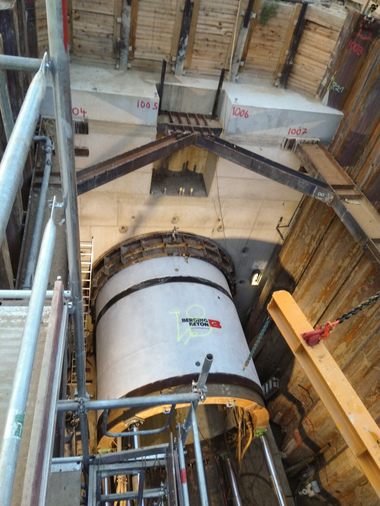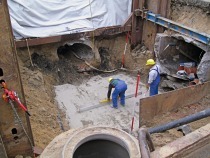Sewer for interference-free drainage replaces pump system
The Göttingen University Hospital (UMG) with its workforce of around 7,500 and 1,460 beds is one of Germany’s leading clinics. Situated in a depression of the metropolitan area, the wastewater and storm water that occurs at the site is currently drained by means of a complex lifting system. An additional large-volume storm water retention basin at the site protects the sewer system from becoming overloaded. The area taken up by this basin will now, for lack of other space, have to make way for the new construction of a ward and an OP wing with intensive care unit.
Against this background, the UMG has now begun with the construction of a new sewer of 1.2-m length and a depth of up to 13 m for draining storm water and groundwater. The gravity sewer is to be completed by the autumn of 2015. In order to meet all requirements of the construction and to ensure long-term utilization, the client has decided to use reinforced-concrete jacking pipes of FBS quality.
Sewer route at greater depth in urban topography
Dipl.-Ing. Detlef Benezé, project manager of the entire project, describes the constructional measures for reorganizing the drainage system: “Having examined many alternatives, a sewer with a gradient of at least 2 ‰, which would also have the storage capacity and overflow to replace the existing storm water retention basin, was chosen as the optimal variety.”
“Determination of the optimal course of the sewer required extensive geological examination,” explained Dipl.-Ing. Markus Gajowski from the engineering consultant, Gajowski, that was retained for this project. The objective was to find an optimal route that would not interfere with the existing complex infrastructure of the pronouncedly heterogeneous geology to the discharge point. For this reason, drilling took place at a depth of between 10 and 13 m to prevent encountering undiscovered bombs from World War II at depth of around 5 m.
Storm water sewer as reservoir
The new sewer will connect the sewer network of the UMG with the drainage system of the freight terminal (GVZ) over a length of 1,210 m. From there, the storm water is drained into the Lutter river. “The capacities of the new sewer are thus designed for the future,” explains Dipl.-Ing. Manfred Fiedler, head of sewer planning and rehabilitation at the Göttingen municipal waste management company (GEB). In dimensioning the system, the higher portion of paved areas that results from the construction measures at the clinic site was taken into account, as well as extreme weather with very high rainfall events.
The sewer consists of three sections of 1,400, 1,600 and 2,000 mm. The longest section of 650-m length and an internal diameter of 2 m will serve as reservoir and replace the current retention system. Due to the construction of the regulating plant at Grüner Weg, the storm water will be released into the receiving water efficiently dosed and in an ecologically sound manner.
FBS pipes guarantee special quality
The special significance of the construction project becomes apparent when looking at the construction process. Ralph Küsters of the I.CO.P. tunnel construction company explains why: “Drilling takes place with a micro-tunneling machine weighing 70 tons, and around 400 jacking pipes, each weighing 15 tons, will be installed and expertly connected over the entire length of the sewer route.”
Due to the prevailing geological conditions, the complex routing and the expected loadings, the client had specified in its invitation to tender reinforced-concrete jacking pipes in accordance with DIN EN 1916/DIN V 1201 in FBS quality. The pipes were manufactured and delivered by the company Haba-Beton, Johann Bartlechner KG, headquartered in Garching near the river Alz in Germany. The project manager Dipl.-Ing. Hubert Stark from the Haba plant in Mantel in the Upper Palatinate region of southeast Germany clarifies: “For the expected exposure classes XC4, XD3 and XA2, the jacking pipes had to be manufactured of concrete strength class C45/55, utilizing a CEM I 42,5 R-HS with high sulfate resistance, a water-cement ratio of ≤ 0,4 and a concrete cover of cmin = 40 mm.”
The pipes were therefore produced to harden in their molds and demolding took place 8 hours after casting at the earliest. The gaskets were designed and certified to resist permanent external water pressure of 1,5 bar.
Continuous quality control
In order to attain the high quality level, the pipe manufacturer had undertaken to implement comprehensive quality assurance measures in the bidding phase as intrinsic part of the contract.
The pipes’ fitness for the intended use in the complex proj-ect had also been extensively demonstrated well in advance of contract award. The comprehensive quality assurance scheme implemented by manufacturer and client during pipe production is documented in a QS quality dossier and available to all parties to the project quasi in real time. Jacking of the pipes of 2000 diameter has begun in December of 2014 and completion was scheduled for the 1st Quarter 2015.

